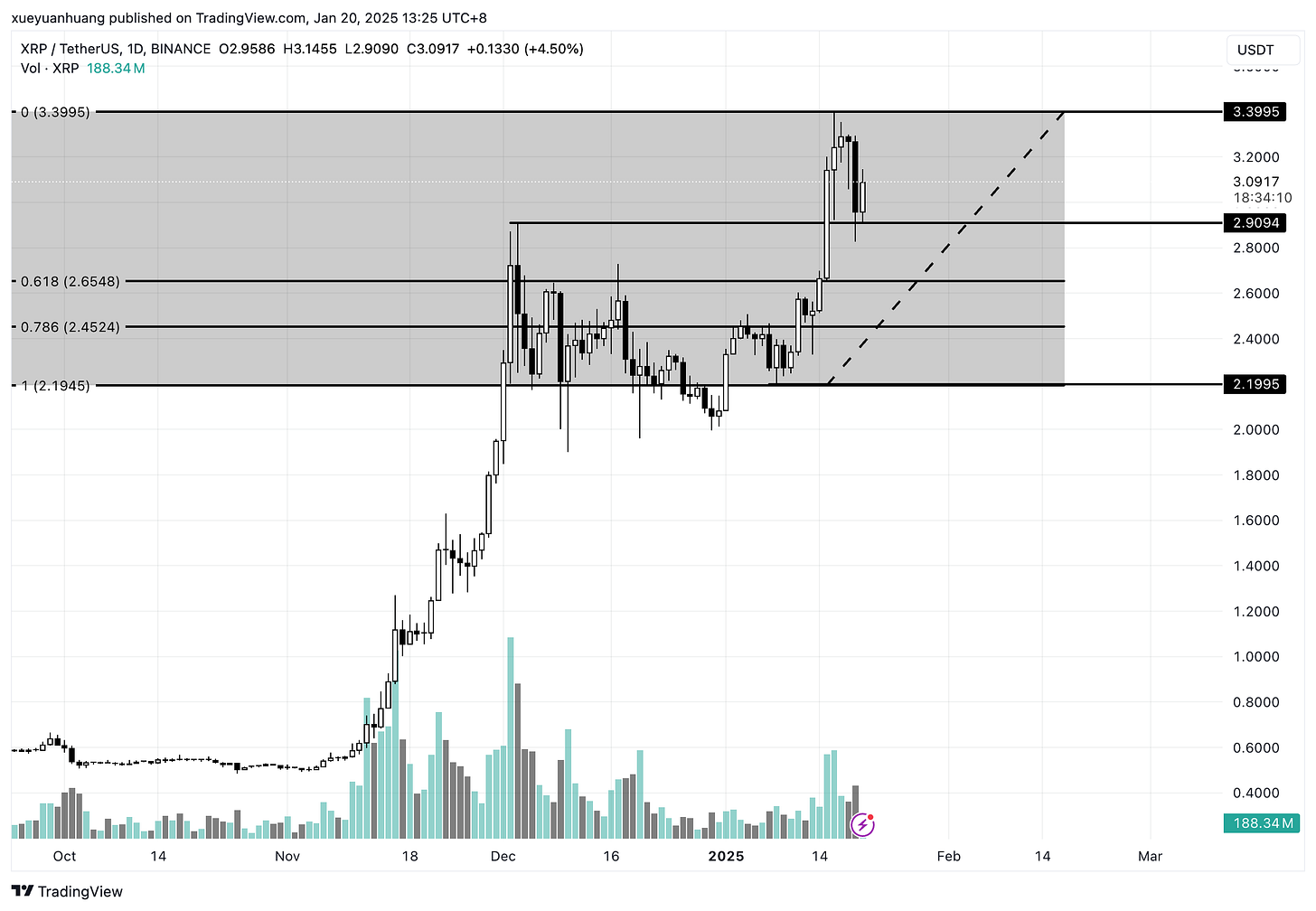The Ripple Revolution
XRP’s Journey to $1,000 and Its Role in the Future of Global Finance
Anyone involved in the crypto ecoshpere will attest that this past year was the year for the Ripple Revolution. In the ever-evolving world of finance, few assets have captured the imagination of investors, institutions, and governments quite like XRP. What began as a digital currency for cross-border payments has now grown into a cornerstone of the global financial system, with Ripple’s technology and partnerships paving the way for a new era of efficiency, transparency, and accessibility. As we approach 2025, XRP is poised to take center stage in a series of transformative events that could redefine its value and utility. From its integration into central banking systems and the derivatives market to its inclusion in ETFs and SWIFT’s global network, XRP is no longer just a speculative asset—it is becoming the backbone of a modernized financial ecosystem.
This essay explores the key developments shaping XRP’s future, its real-world use cases, and the potential for its price to reach $1,000. While such a figure may seem ambitious, the convergence of Ripple’s strategic initiatives and the growing demand for digital assets in global finance makes this scenario increasingly plausible.
XRP’s Real-World Utility: A Foundation for Growth
Unlike many cryptocurrencies that rely solely on speculative trading, XRP has established itself as a utility-driven asset with real-world applications. Ripple’s partnerships with over 300 financial institutions, including Santander, Bank of America, and SBI Holdings, have already demonstrated the power of XRP as a bridge currency for cross-border payments. By leveraging Ripple’s On-Demand Liquidity (ODL) solution, these institutions are able to settle transactions in seconds, significantly reducing costs and eliminating the need for pre-funded nostro accounts.
Beyond commercial banks, Ripple has also forged partnerships with central banks around the world. Over 20 central banks, including the Digital Pound Foundation and the Monetary Authority of Singapore, are actively collaborating with Ripple to develop Central Bank Digital Currencies (CBDCs). These CBDCs are designed to integrate seamlessly with XRP’s liquidity solutions, positioning the token as a critical component of the next generation of global finance.
This real-world utility is not just theoretical—it is already being implemented on a global scale. Ripple’s technology is facilitating billions of dollars in daily transactions, and as adoption grows, so too does the demand for XRP.
ISO 20022 Compliance and Central Bank Integration
March 2025 will mark a pivotal moment for XRP as it becomes fully compliant with the ISO 20022 standard, a global messaging protocol that underpins the operations of central banks, commercial banks, and payment providers. This standard is the foundation of modern banking, enabling seamless communication and interoperability across financial systems.
Ripple’s inclusion in the ISO 20022 ecosystem is a game-changer. It means that XRP will be directly integrated into the infrastructure of global finance, making it a preferred choice for central banks and financial institutions looking to modernize their payment systems. This integration is further bolstered by Ripple’s collaboration with SWIFT, the global leader in cross-border payments. As SWIFT transitions to ISO 20022, Ripple’s technology and XRP’s liquidity solutions will play a critical role in ensuring the smooth flow of transactions across borders.
By aligning itself with ISO 20022 and SWIFT, Ripple is positioning XRP as a bridge asset that can seamlessly connect traditional financial systems with the emerging world of digital currencies. This strategic move not only enhances XRP’s utility but also solidifies its role as a key player in the future of global finance.
XRP’s Entry into the Derivatives Market
The derivatives market, valued at over $1 quadrillion, represents the largest financial market in the world. In July 2025, XRP will officially enter this space, thanks to Ripple’s partnerships with XDC, HBAR, major financial institutions and exchanges. This development is expected to be a turning point for XRP, as it opens the door to trillions of dollars in daily trading volume.
Ripple’s ODL solution, which has already revolutionized cross-border payments, will be expanded to include derivatives trading. This means XRP will be used as a settlement asset for futures, options, and other derivative contracts. The implications are profound: even a small percentage of the derivatives market flowing through XRP could result in unprecedented demand, driving its price to new heights.
The entry into the derivatives market also signals a shift in how XRP is perceived. No longer just a cryptocurrency, XRP is becoming a financial instrument with real-world applications in one of the most lucrative markets on the planet.
ETFs and Institutional Investment
Another major milestone for XRP in 2025 is the approval of Exchange-Traded Funds (ETFs) based on the token. ETFs provide a regulated and accessible way for traditional investors to gain exposure to XRP without directly holding the asset. Ripple has already filed applications for multiple ETFs in collaboration with leading asset managers, and approval is expected by mid-2025.
The launch of XRP-based ETFs will attract billions of dollars in investment from pension funds, hedge funds, and retail investors. This influx of institutional capital will not only boost XRP’s price but also enhance its credibility as a mainstream financial asset.
The $1,000 Hypothesis: A Plausible Future
With these developments in mind, the idea of XRP reaching $1,000 becomes less far-fetched. Let’s break down the potential trajectory:
Short-Term (2025-2026)
ISO 20022 compliance, SWIFT integration, and ETF approval could drive a 50-100% price increase, pushing XRP to $5-$7.
In a moderate scenario, increased adoption and derivatives market activity could result in a 200-300% rise, setting the price at $10-$15.
An exaggerated scenario (From AI), fueled by FOMO and institutional investment, could see XRP hitting $20-$30.
In my opinion, I am seeing XRP over $100 by end of 2025
Mid-Term (2027-2029)
As XRP’s role in the derivatives market expands, its price could rise 300-500%, reaching $15-$25.
Moderate projections suggest a 600-1000% increase, with XRP hitting $40-$50.
In an aggressive scenario (From AI), XRP’s dominance in global finance could push its price to $50-$100.
In my opinion, I am seeing XRP reaching $1000 by 2030
Long-Term (2030-2035)
By 2030, XRP’s integration into central bank systems and its role in the derivatives market could result in a 1000-2000% price increase, reaching $40-$100.
Moderate projections, driven by institutional adoption and technological advancements, suggest a 2000-5000% rise, with XRP hitting $100-$250.
In most optimistic scenario (From AI), where XRP becomes a global reserve currency, its price could soar to $500-$1,000, representing a 10,000-20,000% increase.
In my opinion, I am seeing XRP reaching over $2500 by 2035
I think it’s fair to say that we are seeing the Ripple effect in action. XRP is no longer just a speculative asset—it is a cornerstone of the future financial system. From its integration into central banking systems and SWIFT to its entry into the derivatives market and ETF approval, XRP is poised to become one of the most valuable assets in the world.
While the $1,000 price target remains speculative, the steps Ripple is taking today make it clear that XRP’s potential is far from being fully realized. As the world moves toward a more interconnected and efficient financial system, XRP is uniquely positioned to lead the charge. The Ripple effect is not just a theory—it is a revolution in the making.











M8 can u fact check.
No colaboration between xdc and xrp
Last article u said federal reserve had a xrp wallet, that was wrong also.
Happy to be corrected though